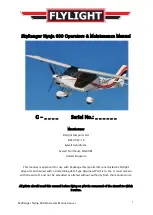
19
Collapses
Asymmetric collapsing of the canopy
The SIGMA 8 features a very taut and stable canopy. With an active
flying technique in normal flying conditions, collapses can be almost
completely prevented. The wing gives very precise canopy feedback
and makes it possible to sense an impending collapse early on, thus
helping timely pilot reaction. Should a collapse occur the wing will
fold in a predictable and progressive manner from wing tip towards
the centre.
If the glider does, however, suffer a side collapse at trim speed, it will
respond to collapses of 50% or more with a slight turning tendency,
allowing heading to be easily held with light counter-steering. Normal-
ly, the wing will reopen without pilot action.
Due to higher aerodynamic forces during accelerated flight the glid-
er will respond to a side collapse a little more impulsively. The sever-
ity of the collapse in accelerated flight is softened because the wing
collapses from the wingtip towards the centre. The turning tenden-
cy in fully accelerated flight will be more dynamic, but is still well con-
trollable.
As a general rule, after an asymmetric collapse, the wing’s direction
must be maintained by controlled counter-braking and internal wing
pressure increased by pumping on the closed side. This speeds up
canopy reopening. Control inputs on the open side should be carried
out carefully in order to prevent this wing stalling.
Poorly executed wingovers may make the wing tips roll in from the
side, often creating cravats. Due to the high drag they produce cra-
vats may lead to strong spiralling. In this case, first prevent a rapid in-
crease in rotational speed by carefully controlled counter-steering.
Then open the hooked-up wing tip by pulling on the red marked sta-
bilo line.
Caution: If you want to make an accelerated collapse during
safety training we recommend that you lead up to it slowly –
starting with unaccelerated and then partially accelerated at-
tempts.
Symmetric collapsing (front collapse)
Following a spontaneous or deliberate front collapse the airflow will
break away from the wing, which will pitch back, followed by the pi-
lot. Wait, without applying any brake, until the wing is overhead again,
give it time to start flying, and then you can stabilise it using the
Summary of Contents for SIGMA8
Page 1: ...User manual SIGMA8 ...
Page 2: ...Edition 01 2011 ...
Page 31: ...31 31 31 ...
Page 34: ...34 Parts Cells Winglet Velcro openings Longitudinal straps Ring Raff System Nylon Wires ...
Page 35: ...35 Lineplan ...
Page 37: ...37 Bowline knot Step 1 Step 2 Step 3 Step 4 Step 5 ...
Page 38: ...38 ...
Page 39: ...39 ...














































